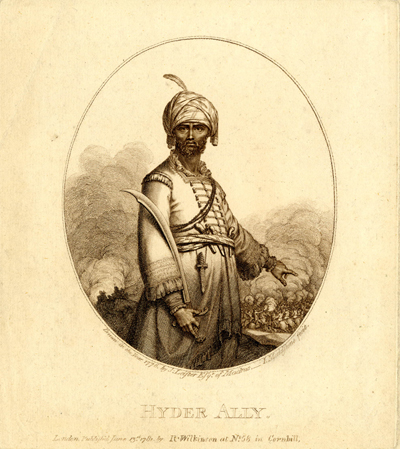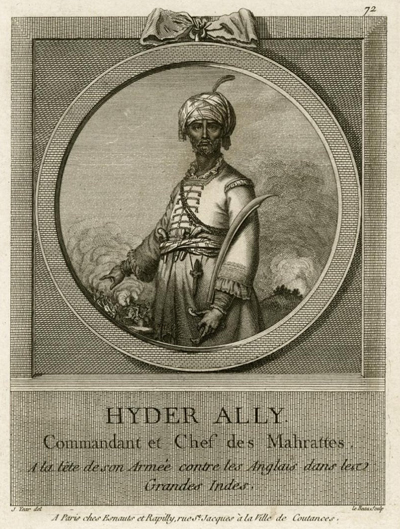Hyder Ally
The British Museum attributes the production of this print to Gillray probably because of his frequent association with Robert Wilkinson, the print publisher, in the year 1781. Indeed Gillray created more prints for Robert Wilkinson that year than he did for the Humphreys.

© Trustees of the British Museum
The print shows Hyder Ally (Haidar Ali), the Sultan of Mysore, scimitar unsheathed, gesturing toward a battle raging behind him. Since 1761 as head of the military in Mysore, he had fought against the colonial aspirations of the British East India Company in the third Carnatic and first Anglo-Mysore wars. In recent months he had once again been in the newspapers as a result of reports of a major incursion by Ali and his troops into the Carnatic. The London Chronicle of March 27, 1781, for instance, reported on the intelligence gained from a number of letters seized during the capture of a French ship.
They inform us that Hyder Ali, the sworn enemy of this country in the East, having collected all his own troops, and been joined by those of the Nizam and other confederate Chiefs and Princes, had marched directly into the Carnatic; and after committing many ravages and devastations, laid siege to Arcot.
The British troops under Sir Hector Monro attempted to stop the incursion, but even with the support of troops from Colonels Fletcher and Baillie, they "were again unfortunately attacked by Hyder Ali himself at the head of a vast army of horse. . .[and] almost all cut to pieces." With much difficulty, Sir Hector was ultimately able to retreat to Madras.
Scratched below the image along with title are the words "Drawn in the year 1776 by J. Leister Esqr. of Madras" and "I. Maidstone fecit." Both are likely fabrications by either Wilkinson or Gillray, because the image of Hyder Ally appears to have been copied from the French print (shown below) which Wikimedia dates from 1762. The Gillray/Wilkinson print is reversed, suggesting that the French print was simply traced and then etched creating a mirror image of the original print.

Hyder Ally, Commandant et Chef des Mahrattes [1762?]
© Wilkimedia Commons
But there is, however, no actual date on the French print, so the date assigned is itself a speculation. One thing is certain, Ali was NOT "Commandant et Chef des Mahrattes" until 1779. Assuming that the lettering on the French print was created at the same time as the image itself, that would place the date of the French print in 1779 or 1780. The print itself indicates that it was engraved by Pierre Adrien Le Beau (1748–), making a 1779/80 date for the print much more likely than 1762. In that case, the image would have been reasonably current in the print market of Paris and likely available to Wilkinson and Gillray. They would have seen the opportunity to exploit the interest in Ally, the "sworn enemy of this country" And since there was little or nothing to prevent them from copying an image from France, they simply traced, etched, and published it.
Sources and Reading
- Commentary from the British Museum on Hyder Ally
- "Hyder Ali," Wikipedia
- "Pierre Adrien Le Beaux," Wikimedia Commons
Comments & Corrections
NOTE: Comments and/or corrections are always appreciated. To make that easier, I have included a form below that you can use. I promise never to share any of the info provided without your express permission.